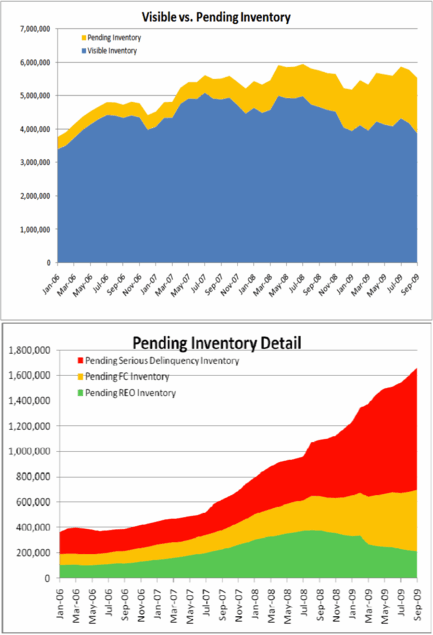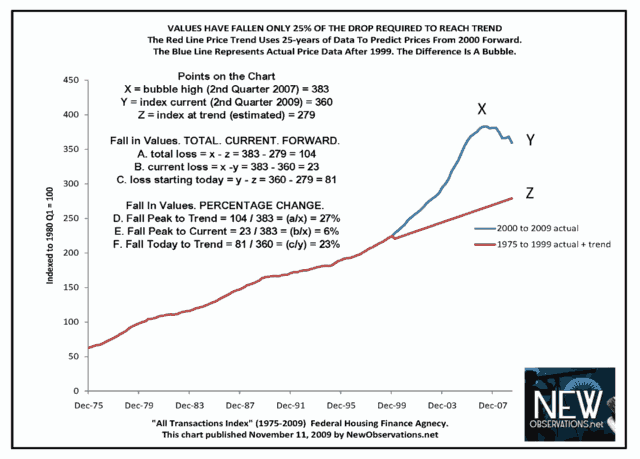
Dynamics

|
Generational Dynamics |
| Forecasting America's Destiny ... and the World's | |
| HOME WEB LOG COUNTRY WIKI COMMENT FORUM DOWNLOADS ABOUT | |
Recent Pollyannaish news stories and news anchors have tried to paint a picture that housing prices have bottomed, and that the housing crisis is pretty much over. People should be wary of such claims, however, since the same people have been saying that housing prices have bottomed almost every month since the financial crisis began in 2007.
|
A new study (PDF) by First American CoreLogic indicates that there's a substantial and growing "shadow inventory" of residential housing.
These 1.7 million homes are not yet on the market, but are headed there soon. They include the following:
The following graphs show the growing size of this shadow inventory:
 |
What's interesting about the above graph is that the "Serious Delinquency" category appears to be growing fastest of all. There are good reasons for this.
First, banks and major lenders have been granting moratoriums on foreclosures, allowing people to stay in their homes well past the normal time a foreclosure would have occurred.
Second, there have government programs designed to reduce the housing inventory. One of these is the Federal Housing Tax Credit, which has been extended into mid-2010. It grants an $8,000 tax credit to home buyers.
Another is the Home Affordable Modification Program (HAMP), which provides cash incentives to the bank or lender to modify the homeowner's mortgage to make it more affordable, so that foreclosure can be avoided.
Actually HAMP has not done anything to reduce the shadow housing inventory, because HAMP has been pretty much a failure, at least so far.
As of October, more than 650,994 loan revisions had been started through HAMP, but not a single one had been converted to a permanent repayment plan. This result caught the attention of the Treasury Dept., and they began to pressure banks to make the loan revisions permanent. However, according to a government press release, only 31,382 revisions have been made permanent, out of 728,000 that had been started as of the end of November.
Those factors explain why the "Pending Foreclosure Inventory" has been growing so dramatically. As this inventory grows larger and larger, the probability of a full-scale housing panic begins to grow.
Banks and lending institutions are aware of this danger, and that's why they've adopted foreclosure moratoriums and other procedures to keep the shadow inventory off the market. But history shows that such techniques can only delay a panic. Once it becomes clear to everyone that prices are falling, then everyone throws houses in the market to get rid of them as quickly as possible, before prices fall even further.
How far will housing prices fall? Mortgage broker Michael David White has done a historical analysis that provides an answer to that question:
 |
According to White's analysis, housing prices are still far above the historical trend line, even though they've already fallen 6%. To reach the trend line, prices have to fall three times as much as they have already.
This is a clear indication that a housing panic will be coming soon.
But actually, it's much worse than that.
I frequently mention the Law of Mean Reversion on this web site, in discussing stock prices. Simply speaking, it says this: Stock prices have been overpriced by a factor of 150% to 250% for almost 15 years -- since 1995; therefore, the stock prices will have to fall sharply, to the Dow 1500-2000 range, and stay well below the trend value for the next 15 years. I didn't invent the Law of Mean Reversion; I'm only telling you what it says. (See "How to compute the 'real value' of the stock market.")
The same law applies to housing prices. White's analysis says that housing prices have to fall three times as much as they have to return to the value indicated by the trend line. That's true, but by the Law of Mean Reversion, housing prices have to fall much farther than that. Roughly speaking, they have to fall as far below the trend line as they went above the trend line in the real estate bubble.
If you examine White's graph, you can estimate that housing prices have to fall to roughly 1990 levels.
As a practical matter, this means that if you decide to buy a house (definitely a bad idea in this market), then you shouldn't pay any more for the house than the market price that the house had in 1990.
|
The growing size of the shadow inventory indicates how this will happen. As the shadow inventory continues to grow, at some point, someone will say or do something that triggers a panic. This will cause prices to fall very quickly to 1990 levels.
(Comments: For reader comments, questions and discussion, see the Financial Topics thread of the Generational Dynamics forum. Read the entire thread for discussions on how to protect your money.)